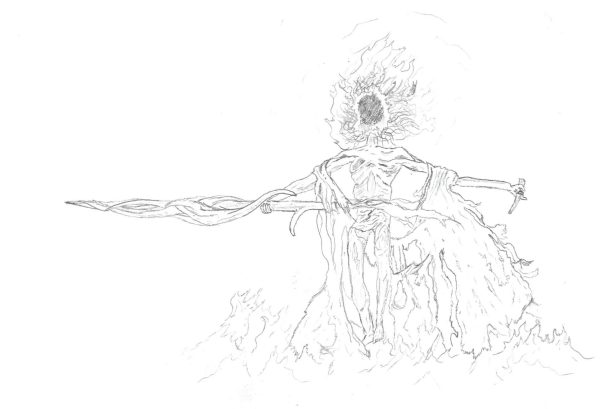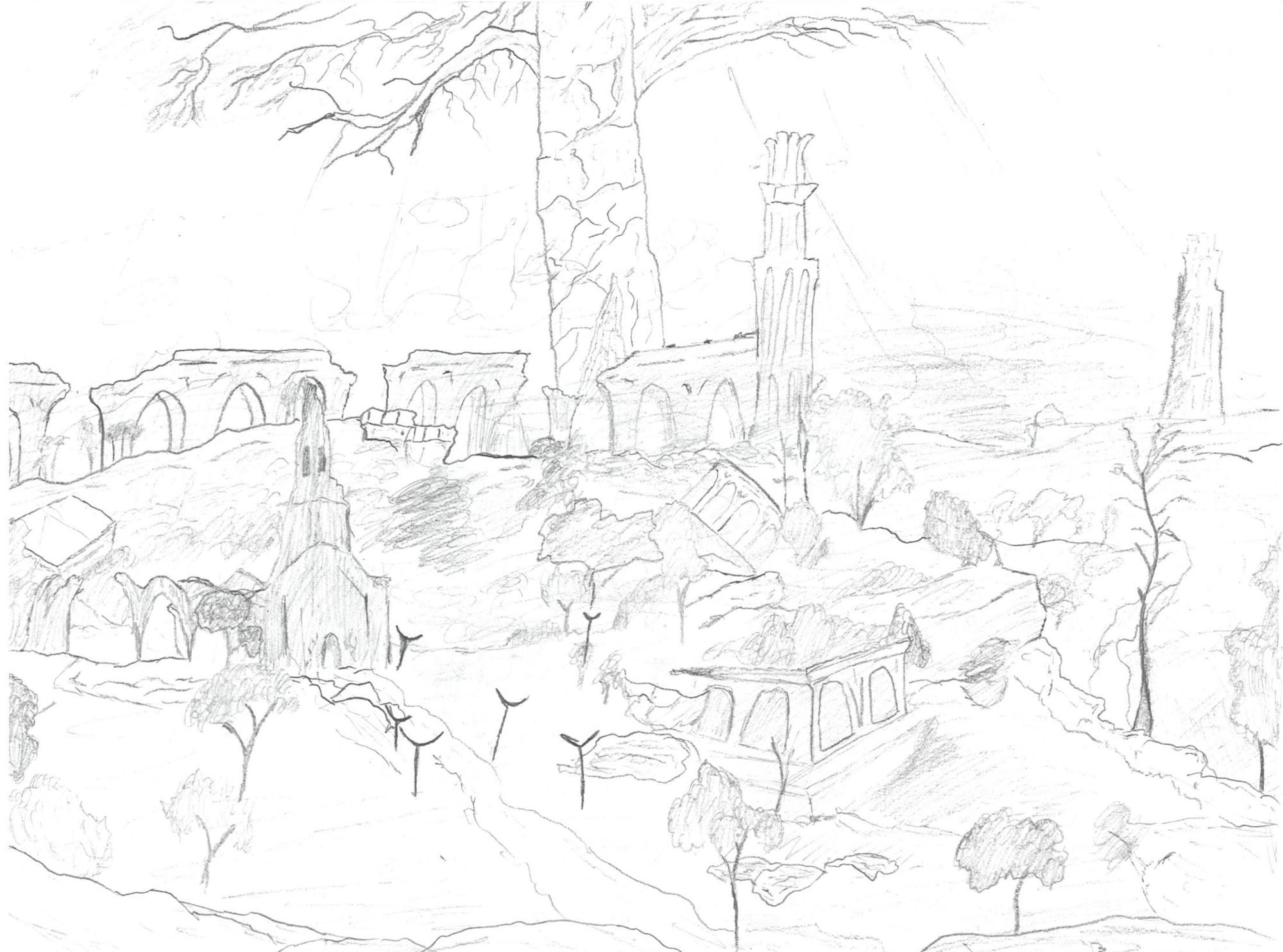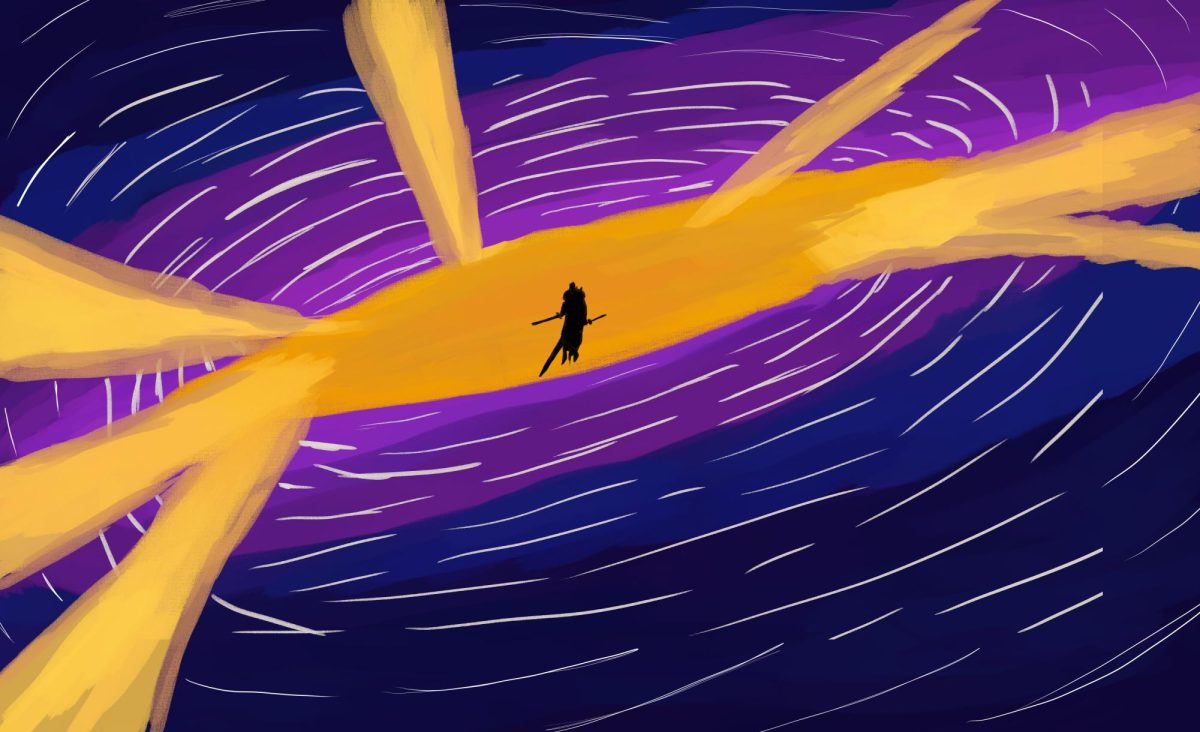Recently, a consistent trend in gaming is a general dumbing down of difficulty. Many Triple-A (large game publishing companies) studios and publishers have decided that challenges in gaming can deter potential customers who may not be up to the task. Over-complicated user interfaces, a lack of content on release, bugs and artifacts of development and more have all plagued recent titles from publishers like Activision Blizzard, Ubisoft, Electronic Arts and even Microsoft.
Japanese studio FromSoftware, however, sees difficulty in a different light. Since 2009, they have been making consistently challenging games, driving players to accomplish nearly impossible tasks. From Demon’s Souls to the Dark Souls trilogy and Bloodborne to Sekiro: Shadows Die Twice, their output has met both critical and commercial success, growing a large fanbase along with it.
But none of their games are like Elden Ring, their 2022 smash hit game that has sold more than 30 million copies. I’m not the first, and I won’t be the last, to say that Elden Ring is an industry defining and defying title. It has pushed the bar of success in gameplay, graphics, story, music and impact much farther than almost any other game this generation.
The Fallen Leaves Tell a Story
Elden Ring’s incredible story and lore is as captivating as it is complicated and hidden.
The story of Elden Ring was written by both FromSoftware’s studio head and the game’s director, Hidetaka Miyazaki, and George R. R. Martin, acclaimed author of the book series “A Song of Ice and Fire”. Both creators are known for their dark and depressing worlds and characters, but somehow, Elden Ring breaks the mold, at least a little bit.
While there may still be lots of death, gloom and ruin scattered about the “Lands Between,” the game’s world, it is filled with color and life that many of FromSoftware’s games have lacked, not just visually in-game, but also in the game’s story.
The story follows a pantheon of gods and demigods native to the Lands Between, known as the “Golden Order,” a religion founded by the mythical figure, Queen Marika the Eternal. She, the prime goddess of the Lands Between, was in possession of the “Elden Ring”, an object of great power that allowed her to control the world. But she decided to break the Elden Ring, locking her away in a massive, world-spanning tree known as the “Erdtree”. This event sparked a massive war between her demigod children, known as the “Shattering,” leaving the world in the broken and scarred state that we find it in on our journey.
You, the player, are one of the “Tarnished,” a race of people that have lost the guidance of the Erdtree’s grace. Now, with the Elden Ring shattered and scattered among the demigods of the Lands Between, your task is to repair it and become the next “Elden Lord.”
While the premise seems simple, there is, quite frankly, an egregious amount of lore and backstory to almost every single element of the game. Every random Non-Player Character (NPC) has their own backstory, every place you go is richly detailed with history, every major boss you beat has a different reason for why you have to fight them and every item you pick up can be traced back to some ancient order or religion. It can definitely get a bit overwhelming at times, but the sheer quantity of lore and story makes the game feel real, like everything could feasibly exist as it does in-game, and that is truly a massive accomplishment.
However, this story isn’t directly told to the player as most games would be. There are no quest markers or journals or anything to help guide the player through the game’s story, and really, the only thing that gives you the game’s lore are item descriptions. The sheer quantity of story and lore makes discovering it quite difficult and tedious through the game. Youtube channels like “VaatiVidya” or “Smoughtown” have built careers out of deciphering the lore and story of these games, presenting them in hour long videos while still only scratching the surface.
So, the story and lore is fantastic and very well written and thought out, but, the way that it’s told is still very antiquated for most players; and without the help of wikis like FextraLife and Youtube videos, it would be hard to understand most of it.
That being said, I still give Elden Ring’s story a nine-and-a-half out of ten stars.
Forefathers One and All, Bear Witness!
Elden Ring’s punishing combat and vast variety of builds makes gameplay rewarding and ever creative.
Something FromSoftware does really well is make the odds seem impossible for players. Stories of slaying gods help, but what really cements its feeling of difficulty is its combat and gameplay.
Before Elden Ring, FromSoftware had already created and refined a combat system of high build variety and mastery. The basis of Elden Ring’s combat is a system dictated by levels and statistics. For the game’s combat, you can use different weapons against enemies, each boasting a light and heavy attack and a special attack called an “Ash of War.” In order to use these weapons, you have to use Stamina, categorized by a green bar on the top right of the User Interface (UI). If you attack, it decreases. If the bar runs out, you can’t attack and will have to wait to regenerate more stamina. It dictates your ability to dodge, attack, jump, run, and more throughout the game, providing a layer of strategy to the game’s combat.
On top of the stamina bar, you also have two other bars, one for HP (or health) and one for FP (which is basically magic cost). Health is one of the most important factors in the game, because it controls how many hits you can take, or mistakes you can make, before you die and respawn somewhere else. FP controls your use of weapon skills and spells. All of this combines to make a combat system that punishes mistakes but rewards creativity and build variety.
Elden Ring, including its Downloadable Content (DLC), Shadow of the Erdtree, has over 300 weapons that you can use in combat. On top of that, you can use different armor sets, talismans and spells to make almost any build viable. Players online have become famous for tackling challenges like “Rune-Level One” runs or “I only level this category” runs, showing just how versatile the game’s combat can be.
You can also, for the first time in the series, summon creatures in fights to help gain an advantage. Many “Souls-Purists” believe that summoning, especially when using the “Mimic Tear” summon, which creates an identical copy of you, is “cheating;” Hidetaka Miyazaki, the director of the game, has a different stance.
“I want to preface this by saying I absolutely suck at video games, so my approach or play style was to use everything I have at my disposal, all the assistance, every scrap of aid that the game offers, and also all the knowledge that I have as the architect of the game,” Miyazaki said in an interview with The Guardian. “The freedom and open-world nature of Elden Ring perhaps lowered the barrier to entry, and I might be the one who’s benefiting the most from that, as a player, more than anyone else.”
So, because of its well-made base combat and expansive build variety, I give Elden Ring’s combat an easy ten-out-of-ten stars.
Put These Foolish Ambitions To Rest
Elden Ring excels in creating challenging and rewarding boss fights, even if they make you go insane.
It’s hard to talk about Elden Ring without mentioning its bosses. FromSoftware is known throughout the gaming industry for their unique, challenging and extremely fun boss design, with notable staples from previous games, including “Ornstein and Smough” from Dark Souls, “Ludwig, the Holy Blade”, “Lady Maria of the Astral Clocktower” and the “Orphan of Kos” from Bloodborne, the “Nameless King” and, my personal favorite boss of all time, “Slave Knight Gael” from Dark Souls III,
Elden Ring continues this trend of excellent boss design with its 25 “Remembrance” bosses and tons of other unique bosses. The game excels in challenging the player by turning their fast-paced moveset, as talked about in the previous section, against them.
I’m gonna talk about a few of my favorites here and explain why they’re so good.
Malenia, Blade of Miquella

Of all of the bosses in Elden Ring, Malenia is the one that most will find the most difficult. She continues another trend in FromSoft’s Souls games, having some of the most challenging bosses hidden in some of the most obscure parts of the game’s world. Malenia is hidden in a part of the world that many will never find a way to get to, known as the “Haligtree”, which requires completing a bunch of tasks that I won’t spoil here. But when you finally get there, you will almost certainly die in the first minute of the fight.
Malenia has an incredibly punishing moveset. She is able to heal off of hits she gets on the player, which happen very frequently. She uses a long katana to slice the player, dealing massive amounts of damage in no-time. This damage is dramatically increased with her signature move, known as the “Waterfowl Dance,” creating a storm of slashes around her that can drive some players mad.
She also has two phases, leading some to a false sense of victory before the game crushes their dreams.
The best part about Malenia, however, is that she is “learnable.” What do I mean by that? Well, in order to succeed, you need to understand what she will do and how to counter it. She’s one of the most difficult bosses to do this with in the whole game, but after a hundred attempts, you’ll be able to recognize patterns and dodge anything she throws at you. The practice it takes to get good at fighting her makes victory feel absolutely incredible.
Midra, Lord of Frenzied Flame

Midra is, personally, my favorite boss in Elden Ring, and that title isn’t one lightly given. The best part of his fight is the way that it flows.
In my opinion, FromSoftware’s bosses work best when they compliment the player’s moveset, acting like a dance of fighting, getting in the rhythm of combat. “Slave Knight Gael” from Dark Souls III, as I mentioned before, is my favorite boss of all time, because his fight expertly flows with the player’s moves, rewarding expert dodging and timing while being insanely cool.
Midra is no different. The fight starts with you having to kill Midra as he is on the ground trying to attack you. Then, the intro cutscene starts, and the chills immediately come through your spine. Now, he is the “Lord of Frenzied Flame”, a being of immense power and of so much lore that I literally am unable to write it down in less than a few hundred words.
You can dodge his attacks, trading hits and making goes at damaging your foe. The combination of his flame attacks and sword swings make it incredibly enjoyable, regardless of the build you have.
I also feel obligated to talk about the music of the fight. As a musician myself, the rampaging waltz that fills your head when fighting the Lord of Frenzied Flame is absolutely incredible. We’ll get into the music later, but this one is my favorite track from the game.
Those are just two of the 25 Remembrance bosses the game has to offer. The best part is that almost all of those 25 bosses are absolutely fantastic to fight.
There is a problem with Elden Ring’s bosses, however, in that there are far too many of them. That number, 25, that I mentioned? Actually, when combining the base game and DLC, it’s closer to 200 boss fights. That is absolutely insane, especially because most of these bosses are just normal enemies with a larger healthpool at the end of a cave or catacomb. So, while the specialty made boss fights are absolutely second-to-none, these enemy-turned bosses are not. However, you don’t have to fight these ones, so I’m not really going to count it against the game.
I will, however, count a critical flaw in many of Elden Ring’s boss encounters, which is poor balancing. Where some games have level-scaling areas that adapt the difficulty to where you are in the game, Elden Ring doesn’t, and that can lead to some ridiculous scenarios where you go from one place to another and immediately lose all sense of security you have with your play style. The bosses can come in many different numbers, particularly in pairs. One of the most prolific bosses in the game is the “Godskin Duo”, a duo boss that is absolutely abysmally designed, specifically because it takes two great solo bosses and shoves them into a room with each other, creating chaos and pandemonium.
But despite a lot of design flaws that may come with some bosses (I’m looking at you, Godskin Duo), Elden Ring’s boss design is still some of the best in the industry, and it constantly rewards learning each fight and perfecting your play style.
I give Elden Ring’s boss fights a nine-and-a-half out of ten stars.
The Impenetrable Thorns Refuse All
Elden Ring’s expert combination of its large open world and tightly designed dungeons makes traversal and puzzle solving both challenging and engaging.
A staple of FromSoftware’s Souls games has been their expertly crafted, intertwined level design. The Dark Souls Trilogy has shown this off quite well, with large maps and levels all twisting around each other. These levels, while well made, are still fairly closed-off and linear. Elden Ring, however, is in an entirely different genre, being “Open World”.
Elden Ring takes the established level design of FromSoftware’s previous games and turns it on its head. Now, most of the game’s world is made up of large swaths of land and openly explorable sights. The base game’s map, “the Lands Between”, is made up of a few large sections of open areas to explore.
“Limgrave”, the game’s starting area, is characterized by its greenery and vistas, as well as its colossal ruins from eras long forgotten. Limgrave leads into two more areas: “Caelid”, a rot infested hellscape with mangled enemies and terrifying bosses, and “Liurnia of the Lakes”, a much more serene valley filled with trees and water, ruins and magic. Then, there’s the “Altus Plateau”, home to orange and gold grass and foliage, battle-beaten ruins and fog-flooded forests. There’s “Mt. Gelmir”, a wartorn volcano harboring a large mansion and prison known as “Volcano Manor”. Then, the last two open areas of the game are the “Mountaintops of the Giants” and the “Consecrated Snowfield”, both frozen and ancient lands harboring old secrets.
However, these large open-world sections aren’t really where the bulk of the game is. In fact, each of these areas has their own unique structures that expand on the level design of FromSoftware’s previous Souls games. These places are known as “Legacy Dungeons”. They vary in shape and size, as some are caves or catacombs scattered and hidden across the world, while others are large castles or cities that you can fully explore.
Limgrave plays host to “Stormveil Castle”, a beaten ruin co-opted by one of the game’s main bosses, “Godrick the Grafted”. Liurnia of the Lakes houses the magical “Academy of Raya Lucaria”, filled with mages and ruins that rise high above the lake below. Mt. Gelmir has the aforementioned “Volcano Manor”, a dilapidated mansion with a prison in its backyard. Mountaintops of the Giants leads to “Crumbling Farum Azula”, a bastion of dragons stuck in time and filled with large tempests.
But Altus Plateau’s legacy dungeon is far more unique than the others, and it is widely considered the best one in the game. This dungeon, “Leyndell, Royal Capital,” is a golden city surrounded by walls at the base of the Erdtree. The best part of the city is that anything you see, you can go to. That large statue of a dragon? You can climb it! That tower at the base of the Erdtree? That’s right! You can go there.
The impressive combination of sprawling open-world levels and intricate dungeons makes Elden Ring incredibly enjoyable to get lost in, and it’s one of the most fun parts of the game.
I give Elden Ring’s world and level design ten-out-of-ten stars.
Leave the Path Forward to Us
Elden Ring’s beautiful art direction and fantastic music make the game an absolute joy to witness.
Currently, in the Gaming Industry, there’s a dramatic push to try and make games look insanely realistic and detailed. Yet, most of the time, they come off as bland and uninteresting, more cookie-cutter slop to pay $70 for.
Elden Ring, while still having great graphical fidelity and performance, truly stands out amongst the crowd because of its fantastic art.
The world of the Lands Between is covered head-to-toe in monumental structures, ruins of ages past and wreckage of wars lost to time. The architecture and colors highlight the “vibe” of each area. Caelid’s smouldering ruins and red-bleached skies, matched with gigantic fungal growths and well-worn soldiers, immediately tells the player the apocalyptic nature of the region. That’s just one of the many unique areas that all feel incredibly unique and special.
Each area, and each boss-fight in particular, is also highlighted by the fantastic music of the game. Expertly composed by Yuka Kitamura, Tsukasa Saitoh, Shoi Miyazawa, Tai Tomisawa, Yoshimi Kudo and, in Shadow of the Erdtree, Soma Tanizaki, it brilliantly underscores the game.
Each song adds to each boss encounter and area you discover. Some of my favorites include:
“Godskin Apostles”, “The Twin Moon Knight” and “Bayle the Dread” by Tai Tomisawa
“God-Devouring Serpent” and “Lichdragon Fortissax” by Yoshimi Kudo
“Leyndell, Royal Capital”, “Malenia, Blade of Miquella” and “St. Trina” by Yuka Kitamura
“Elden Ring”, “The Final Battle”, “The Saint of the Bud” and “Messmer the Impaler” by Tsukasa Saitoh
“Godrick the Grafted”, “Mohg, Lord of Blood”, “Beast Clergyman”, “Divine Beast Dancing Lion”, “The Lord of Frenzied Flame” and “The Promised Consort” by Shoi Miyazawa
The abundance of tracks I listed all are absolutely phenomenal, heart pounding pieces that each expertly match their intended fights or areas. I’d highly recommend listening to them all, as each and every one is a masterclass in compositional wonder.
Everything about the game’s presentation is absolutely phenomenal and, as I have already said about tons of other elements in this review, is one of the best parts of the game.
I give Elden Ring’s music and art direction ten-out-of-ten stars, too.
Those Stripped of the Grace of Gold shall all meet Death
Elden Ring: Shadow of the Erdtree, the 2024 expansion to the game, is everything good about the main game dialed to eleven and expertly crafted to enhance the original even further.
This section includes spoilers for Elden Ring: Shadow of the Erdtree.
Everything I’ve already said about Elden Ring can also be said about the game’s DLC, Elden Ring: Shadow of the Erdtree. The expansion adds an absurd amount of content to the game, from ten new Remembrance bosses to a massive, even better designed map than the base game.
The Land of Shadow is chalked full of new story and lore. The mystery the DLC presents about the demigod Miquella is gripping, and the way the narrative unravels as you make your way through the Land of Shadow is incredibly interesting. The lore of the land is also, somehow, even greater than the base game, with the remnants of fleshed-out civilizations gone by strewn and detailed all across the map.
The bosses are somehow also another improvement on the base game. The DLC includes ten new remembrance bosses, with most being incredibly fun to fight. My stand-outs are: Midra, Lord of Frenzied Flame; Rellana, Twin Moon Knight; Messmer, the Impaler; Bayle the Dread and Divine Beast Dancing Lion. Each of these bosses has a crazy level of quality put into them, with each boss having fantastic art direction, music, design and an overall layer of polish that you just don’t get anywhere else.
However, for as good as the DLC is, it is still more of the base game, which means that there are some flaws. While I mentioned some fantastic bosses the Land of Shadow offers, some of them are painfully bad, like Commander Gaius, who’s hitboxes will have you looking at the screen in complete dismay, or Metyr, Mother of Fingers, who is absolutely grotesque in both visual and gameplay design. The new level-up systems of Scadutree Fragments and Remnant Spirit Ashes, while they level the playing field and guarantee a similar experience for all players, are hard to find. They’re hidden behind obscure puzzles and don’t have any redundancy, so you’ll have to go through guides to find all of them and check spots that you may have already found to reach maximum level.
Yet, most of these drawbacks don’t really matter. The experience is still fantastic. I’ll keep this section brief, as I hope you play through this when you go through the base game. Shadow of the Erdtree is just as good, if not better than the base game. It’s interesting setting, fun and unique bosses, incredible world design and lore and immense polish makes it fun to go through again and again.
I give Elden Ring: Shadow of the Erdtree a nine-out-of-ten stars.
Thou’rt a Trueborn Heir
Elden RIng, despite some flaws, is an absolute masterpiece and worth everybody’s time. Just keep in mind that it is very hard.
Elden Ring, in its totality, is a masterpiece of a game. Its art and music is fantastic and detailed, the lore and story is masterfully written and the gameplay is second to none. It seems everybody also is in agreement. Elden Ring’s Metacritic score, a collection of user and critical reviews for the game, is a staggering 96 out of 100. Shadow of the Erdtree even holds a 94 out of 100. Elden Ring won “Game of the Year”, “Best Game Direction”, “Best Art Direction” and “Best Role Playing Game (RPG)”. Now, with the game releasing on the Nintendo Switch 2 at launch, along with the release of a multiplayer spin-off, Elden Ring Nightreign, which comes out May 30, the game is more accessible and interesting than ever. I highly recommend Elden Ring, just as long as you can handle an extreme challenge.
I give Elden Ring a score of ten-out-of-ten stars.




![Lesbian Visibility Day is April 26, and it’s a holiday to celebrate the lesbian community of the world. Lesbian Visibility day was established in 2008 by many queer activists and organizations who sought to raise more awareness for lesbian history and culture. “So this is why during Lesbian Visibility [Day] we celebrate and center all lesbians, both cis and trans, while also showing solidarity with all LGBTQ+ women and nonbinary people,” Linda Reily, in an article written by her, said.](https://rockmediaonline.org/wp-content/uploads/2025/04/Lesbian-Visibility-day.jpeg)



